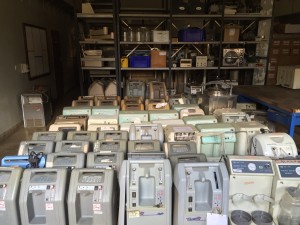I wince as I turn the oxygen concentrator on. A shrill alarm fills the air, informing me that the concentrator’s powered up, and a loud hum fills the air as the compressor inside starts to suck in air.
I’m taking apart an oxygen concentrator in Lilongwe, Malawi’s Kumuzu Central Hospital. Next to me, Harvey, my partner from Malawi’s Polytechnic University, jots down an oxygen concentration as I hold the concentration meter’s tube close to the concentrator’s nozzle. We don’t have an adaptor, so I’m holding it steady as best I can.
“Is this thing o -”
The numbers start to jump. 22, 34, 56, 63.
Grimacing, I look up at Harvey.
“Concentration’s at 63%. It should be hitting 90%, at the least.”
Our first day in Kamuzu Central Hospital marks the start of a 5-day pursuit. Our goal here is two-fold. First, we’re trying to figure out why so many oxygen concentrators fail.

When these concentrators break, they’re brought to the Physical Assets Management (PAM) department for repair. The engineers here in the hospitals are filled to the brim with these machines. Instead of being in use, the machines are stranded in the workshop with the PAM engineers doing their best to get them up and running. Even after our first day, seeing the engineers here strip down broken machines for parts and repair concentrators with what they have available has inspiring to see and be part of.
We want to figure out why so many of these concentrators fail. Is it a rogue resistor, burned out due to a power surge? Has the compressor failed? Have the filters gone bad? Are the sieve beds that help concentrate the oxygen faulty? What’s the weak link in the chain? By taking these concentrators apart, by performing diagnostics on them, we are trying gather enough information to start designing long-term solutions to common modes of failure with these concentrators.
Our second goal is to study the “warm chain” for neonates after they’re delivered. Our goal is to reduce the incidence of neonatal hypothermia, and in order for us to do that, we need to understand what happens to neonates once they’ve been delivered.
With both of these goals, we’re talking with nurses and physicians, making observations, and doing our best to paint a full picture of the needs that are present. The work we do during our week here in Lilongwe along with the other clinical sites being visited will form the foundation for the next 5 weeks of our internship. This part, the needs-finding, is a reminder that carefully considering what the problem is just as important as designing the solutions to address the problems.
If we leap too quickly, the solutions we design won’t address the true problem. As a student, we’re often presented with carefully crafted problems and asked to fix them. Rarely are we able to carefully forge a problem on our own. Rarely do we get to scope out the field, compile observations and interviews, and transform that data into a thought out need. But that’s exactly what we’re doing during this week. Let’s see what the bigger picture ends up looking like!